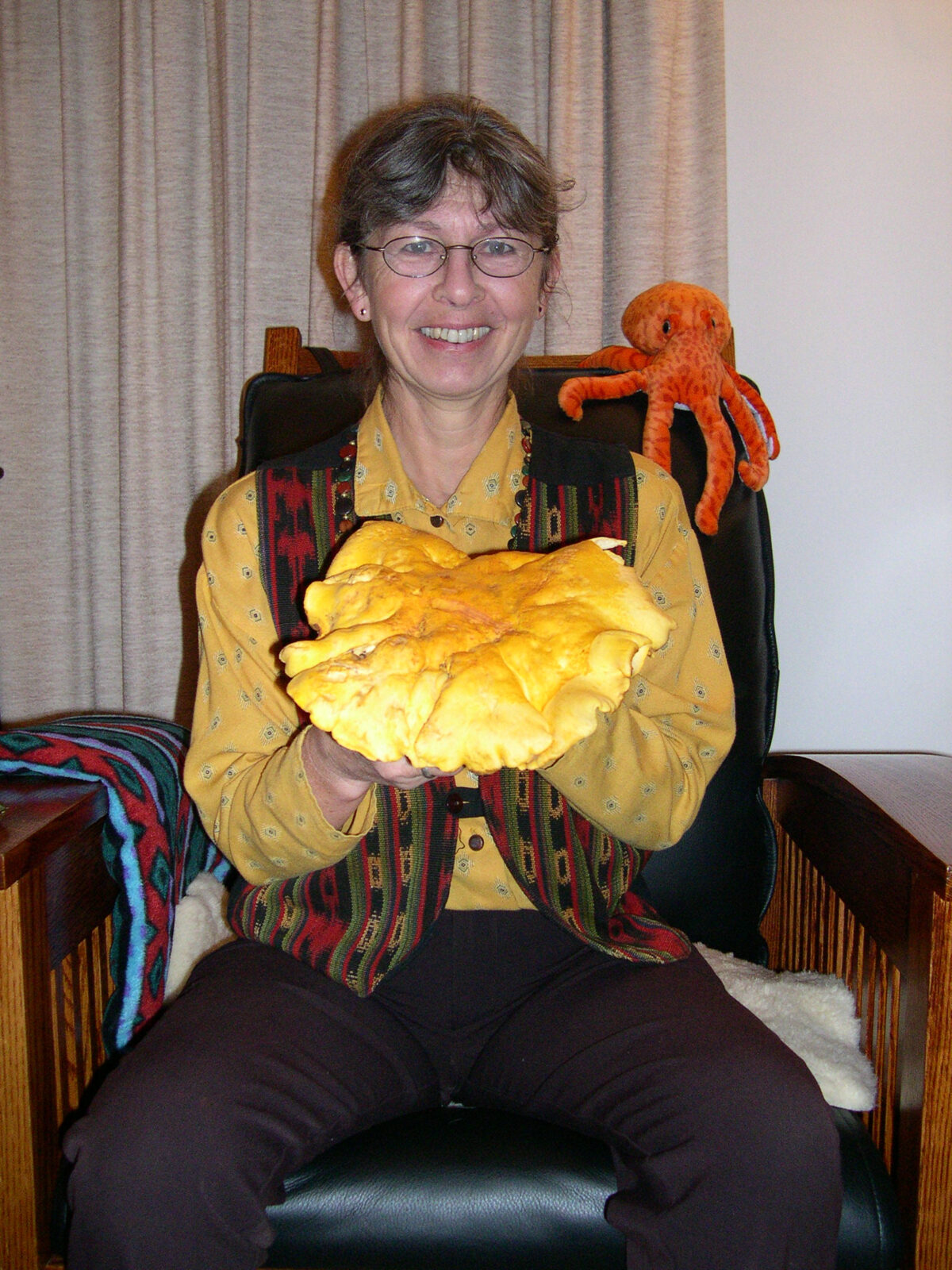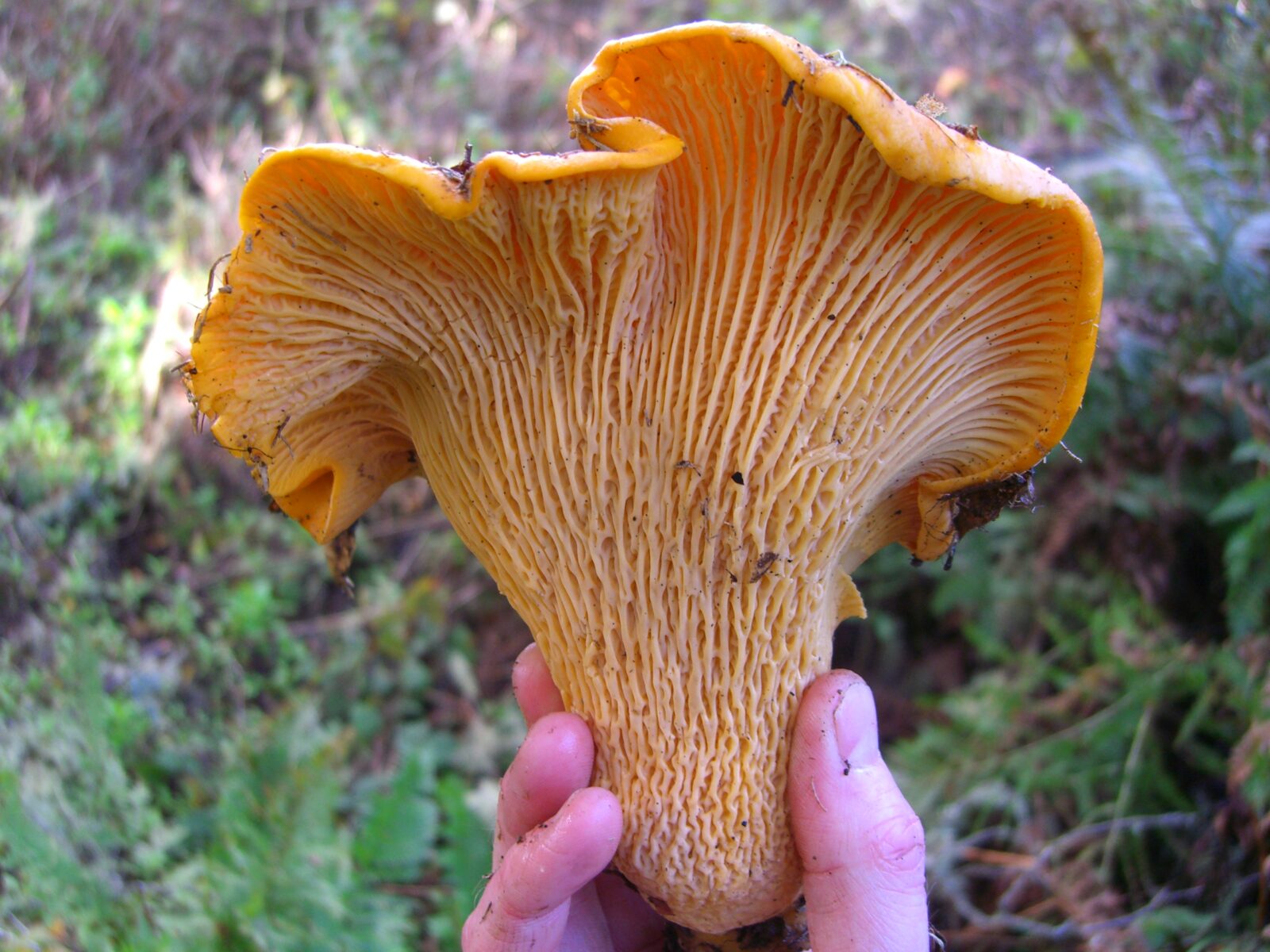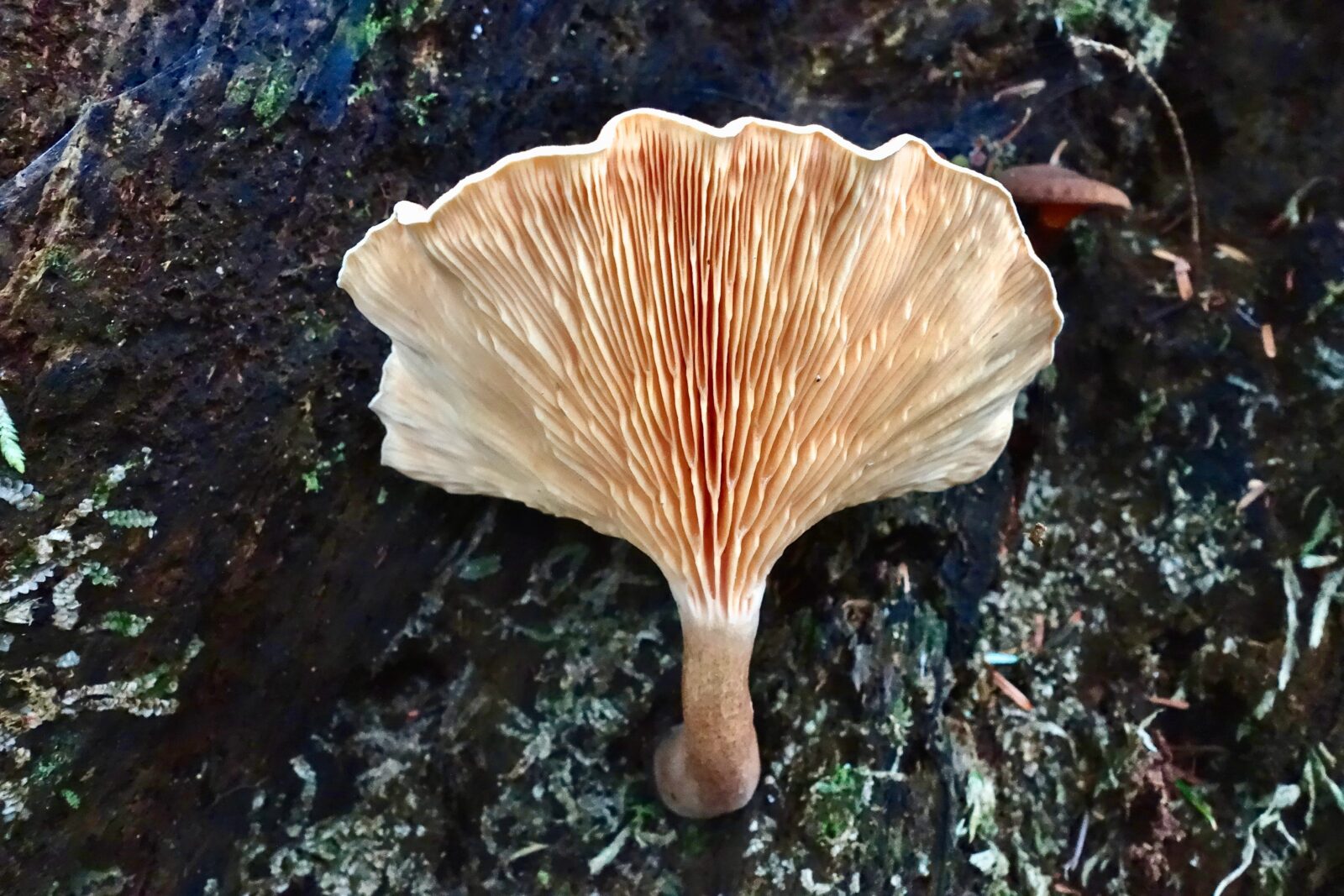[ad_1]
The phrase “the golden hills of California” evokes a picture of hills of golden grass, rippling within the wind. However to a mushroom hunter in our verdant, winter wet season, it will probably imply one thing fairly completely different. Greet a brand new type of gold: the California golden chanterelle, Cantharellus californicus. Described by David Arora and Susie Dunham in 2008, this monster chanterelle—the most important on the earth—has impressed and fed native mushroom hunters for generations. Previously lumped underneath the catch-all title of Cantharellus cibarius, however separated out by each morphological characters and distinct DNA variations, simply certainly one of these golden beauties can feed a household of 4—with leftovers!
In late 2023, the California golden chanterelle, native to California and the northern Baja Peninsula, grew to become our very first state mushroom. It edged out numerous fungal contenders, together with its almost-as-popular, West Coast endemic, poisonous lookalike, Omphalotus olivascens, the jack o’ lantern mushroom. A number of mushroom species have been proposed for consideration inside the native mushroom-enthusiast neighborhood, and voted upon by members of California mushroom golf equipment and California mushroom hunters. The winner was offered to the California legislature for official recognition, in a invoice launched by state Meeting member Ash Kalra, D-San Jose, after which handed by the Meeting into regulation. California joins solely a handful of different states with state mushrooms. Oregon was the primary to have a golden chanterelle as its state mushroom, the commercially useful Cantharellus formosus. However ours is greater.
California golden chanterelles develop from the bottom in a mutualistic, mycorrhizal partnership with reside oak timber. Their fluted types stud the sun-dappled oak duff with splashes of gold, and may typically be thickly buried beneath it. Chanterelles have an general golden orange shade, shallow gill ridges as a substitute of deep true gills, and white internal flesh. They generally present an orange-red staining or bruising or perhaps a sort of rot with age and dealing with. What accounts for such shade adjustments has not been decided, nevertheless it ought to be fully trimmed off earlier than consuming the chanterelle.
California golden chanterelles dwarf the competitors because of their ongoing development within the discipline, a phenomenon known as “indeterminate development,” related to what’s seen in sure tomato species. Most mushrooms, and even most chanterelles, produce a short-lived fruit physique with a spore-bearing floor, shed their spores, after which rot away. Cantharellus californicus continues so as to add fertile layers atop the outdated—producing spores over a interval of weeks or months fairly than days, and rising ever bigger and extra advanced in form over time.

Two different species of chanterelle additionally happen within the larger Bay Space, from Marin County to Santa Cruz County, however in far lesser numbers: Cantharellus formosus, one other one of many golden chanterelles, which has a slimmer type and likes conifer hosts, and the white chanterelle, Cantharellus subalbidus, which is whitish to cream-colored. C. subalbidus, stocky like C. californicus however considerably smaller, can be discovered with conifers and in combined tan oak/madrone woodlands. Solely our new state mushroom, the California Golden Chanterelle, grows in affiliation with true oaks. It’s discovered primarily with coast reside oaks, Quercus agrifolia, however may affiliate with different oak species, together with deciduous oak, and even typically with tan oak, Notholithocarpus densiflorus.
Fall and winter is the best season for California golden chanterelles, however they will seem all through the spring and even in the summertime or early fall in areas of coastal fog drip. Early rains can stimulate the mushroom mycelia to type quite a few primordia—knots of tissue representing chanterelles in miniature. Below the proper situations, these primordia change into full-blown chanterelles, with time and extra water. As native mushroom hunters are effectively conscious, the situations for the 2023/2024 chanterelle season have been superb, and the fungal outcomes spectacular.
We might like to eat these huge mushrooms, however different animals, together with widespread fungus devouring bugs, appear to eschew them. Strikingly not like the well-wormed chanterelles from different elements of the nation, mushroom maggots are by no means an issue with these California chanterelles. I’ve on uncommon events noticed a sort of millipede in holes on chanterelles, however I think that these insect predators are simply utilizing the mushroom as searching habitat and shelter. Even snails and slugs don’t appear to look after the style of chanterelles.

It’s not simply the creepy crawlies in our woods that disdain them. I’ve by no means seen proof of squirrel nibbles on a chanterelle (like we generally see with king boletes or matsutakes) or deer eating, and even foraging by the in any other case omnivorous, omnipresent feral pigs. Pig trails can go proper by chanterelle patches, however they depart the mushrooms unbitten, though typically trampled or rooted in passing. Pigs do eat many different edible mushrooms, together with grisettes and mild-flavored russulas.
I suppose that simply leaves extra for us!
The most important draw back to the California large chanterelle is its typically muddy floor and sodden texture. It may be exhausting to remain clear and dry if you end up out within the discipline for months on finish! Though you could have been cautioned to by no means wash your mushrooms, except you benefit from the style of grime, you’ll undoubtedly wish to wash these. The truth is, these “mud-puppies,” as some hunters affectionately name them, are so sturdy that they will stand as much as an excellent hosing, so long as you retain it to a delicate spray. It’s then greatest to permit them to air-dry for a day or so in a cool place. I place them on newspapers, which helps to attract off that further water. As soon as clear and dry, they are often saved for weeks in a fridge, in sealed Tupperware containers lined with paper towels. They can be prepped and frivolously sautéed after which frozen to be used at one other time. Drying will not be advisable as a result of resultant leathery texture. For extra details about preparation, storage and cooking, see this web page on the Bay Space Mycological Society web site.
California golden chanterelles have one notable poisonous lookalike, the aforementioned jack o’ lantern mushroom. This critically GI-toxic species grows on useless wooden (which can be buried within the floor), has deep, true gills with a greenish forged, and orange fairly than white internal flesh. For a very long time it was additionally believed to be hallucinogenic, nevertheless it seems it was simply delirium produced by dehydration from fluid loss! Its greatest declare to fame is that it’s bioluminescent, and glows strongly at the hours of darkness.


Omphalotus olivascens, the western jack o’ lantern mushroom, is a chanterelle lookalike that’s to not be noshed. Don’t be fooled! Look underneath the cap to search out their true gills, fairly than the forked ridges attribute of chanterelles (as proven on this closeup). Additionally, they glow at the hours of darkness. (Clockwise from high left: Nathan Wilson by way of mushroomobserver.org, CC-BY-SA, Harte Singer by way of mushroomobserver.org, CC-BY-NC-SA, Shane Reyes-Marsh by way of mushroomobserver.org, CC BY-NC-SA 4.0, Alan Rockefeller by way of mushroomobserver.org, CC-BY-SA)
The so-called false chanterelle, Hygrophoropsis aurantiaca, is one other chanterelle look-alike, however yet one more prone to produce disappointment than sickness. New hunters, determined to search out an edible wild mushroom, have mistaken these widespread orange mushrooms for chanterelles within the discipline. Their considerably brownish caps, tender, fragile flesh, and true gills that fork on the cap’s edge separate them from their Cantharellus counterparts.
Threats to the continued well being and abundance of those widespread edible fungi are several-fold, and primarily concern the well being of their host timber: coast reside oak, black oak and tan oak. The continued unfold of Sudden Oak Demise or SOD, the razing of oak woodlands to create vineyards and different human encroachments, drought and local weather change all influence the continued fruiting of California golden chanterelles. So does competitors for house on the host oak tree roots by the invasive, launched, lethal mycorrhizal fungus Amanita phalloides, the loss of life cap.

Phytophthora ramorum, a species associated to the Phytophthora that brought on the Irish Potato Famine, is the agent accountable for SOD. An launched pathogen, it has killed many reside oak and tan oak timber within the Bay Space, and continues to take action. There is no such thing as a remedy for a SOD an infection, although some oak species just like the Shreve oak (Quercus parvula) could also be naturally resistant. Lifeless oaks produce no chanterelles. The destruction of oak woodlands for vineyards and different human initiatives is an ongoing concern. Take away the oak, take away their chanterelle companions. Drought and local weather change are affecting all of our forests, and the fungal species that rely upon them.
The case of unfair competitors between Amanita phalloides and California golden chanterelles remains to be an open query. Demise caps in California produce unusually sturdy mycorrhizal connections with their reside oak host timber, far bigger and extra plentiful than seen of their native lands. In addition they typically infect oak timber which can be already producing chanterelles. A number of mushroom hunters, together with myself, have observed decreased manufacturing of chanterelles in timber that now host an abundance of loss of life caps. Coincidence, or trigger? The outcomes will not be but in.

For now, the present mushroom season has produced copious quantities of those glorious and widespread edible mushrooms. Search for them underneath coast reside oak across the Bay Space and past, wherever reside oak and fall/winter (and even the odd summer time) rains coincide. However bear in mind, not each season is like this one. It takes numerous power, from each tree and fungus, to provide a large fungal fruiting, so don’t count on one other certainly one of its ilk for some time.
If a identified “chanterelle oak” doesn’t produce chanterelles once more subsequent 12 months, be affected person—when situations are proper they are going to seem, as if by magic, and our California hills will as soon as once more run with gold: the consuming form.
This piece was up to date in January 2024 for Bay Nature, from a model first revealed on the Bay Space Mycological Society’s web site.
[ad_2]

